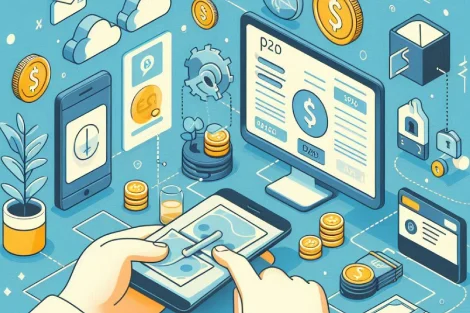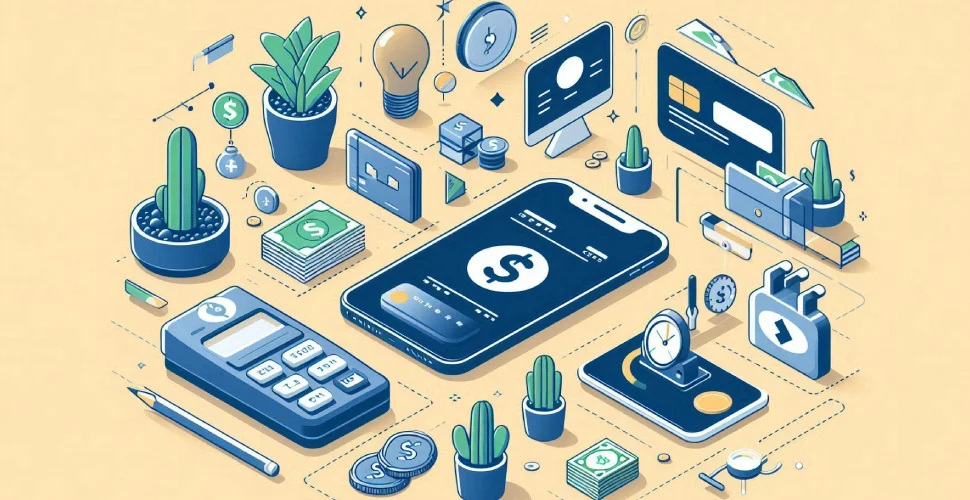How To Build a P2P Payment App?

Introduction
The world of finance is undergoing a dramatic transformation, driven by the rapid rise of technology. Peer-to-peer (P2P) payment apps are at the forefront of this revolution, offering users a convenient, secure, and cost-effective way to send and receive money. From casual payments between friends to settling business transactions, P2P apps are becoming increasingly ubiquitous.
This article delves into the fascinating world of P2P payment app development, providing a comprehensive guide on how to build a successful application from the ground up. We will explore the essential components, technical considerations, and strategic decisions that go into creating a user-friendly and secure platform for financial transactions.
Whether you're a budding entrepreneur with a vision for a new P2P app or simply curious about the behind-the-scenes workings of this exciting industry, this article will provide valuable insights and actionable advice.
What is a P2P Payment App?

A P2P (peer-to-peer) payment app is a mobile application that enables users to transfer funds directly between one another, without the need for a traditional bank or financial institution. This type of app allows individuals to quickly and easily send money to friends, family, or acquaintances using their smartphones. P2P payment apps are becoming increasingly popular due to their convenience and ease of use. They offer a secure and efficient way to make payments, eliminating the need for cash or checks. With just a few taps on their device, users can send and receive money in real-time, making it an ideal solution for splitting bills, paying back loans, or even making online purchases.
How Do They Work?
P2P payment apps, also known as person-to-person payment apps, are digital tools that allow individuals to send and receive money directly from their smartphones. These apps have become popular due to their convenience, security, and speed. But how exactly do they work? Here are some key points:
- Registration: To use P2P payment apps, users must first download the app and register for an account by providing personal information such as name, email, and phone number.
- Linking bank accounts or credit cards: In order to fund transactions, users must link their bank accounts or credit cards to the app.
- Initiating a transaction: Once the account is set up and linked, users can initiate a transaction by choosing the recipient's contact information or scanning a QR code.
- Processing the payment: The app will then verify the sender's identity and transfer funds from their linked account to the recipient's account.
- Instant transfers: P2P payment apps usually offer instant transfers between users who have accounts with the same app.
- Transaction fees: While some P2P apps offer free transactions, others may charge a small fee for using their services.
- Security measures: These apps utilize advanced security measures such as encryption technology and multi-factor authentication to ensure secure transactions.
- Record-keeping: Users can view past transactions within the app for record-keeping purposes.
- Integration with other services: Some P2P payment apps also offer additional features such as splitting bills or making payments at participating merchants.
Key Features of a P2P Payment App

- User Authentication: Secure methods to verify users' identities, such as two-factor authentication.
- Instant Fund Transfer: Enables users to send and receive payments in real-time.
- Contact List Integration: Allows users to send money to contacts in their phone or app address book.
- Fraud Protection: Advanced algorithms and measures to detect and prevent fraudulent transactions.
- Transaction History: Provides users with a record of all their transactions.
- Cross-Platform Compatibility: Works seamlessly on various mobile and web platforms.
Strategies for Generating Revenue with Your P2P Payment App
The P2P payment app market is thriving, offering a convenient and secure way for users to send and receive money. But how do you transition your app from a free service to a profitable business? The key lies in diversifying your revenue streams beyond transaction fees.
Here are some effective strategies:
Transaction Fees: The Foundation
While a simple and straightforward approach, transaction fees are often the starting point for P2P app monetization.
- Per-transaction fees: Charge a small fee for each transaction above a certain threshold.
- Tiered pricing: Implement a tiered system where fees decrease with increasing transaction volume.
- Dynamic pricing: Adjust fees based on factors like transaction amount, time of day, or user location.
Subscription Models: Value-Added Services
Instead of relying solely on every transaction, offer premium features and services through subscriptions:
- Faster transfers: Prioritize faster transaction processing for subscribers.
- Enhanced security: Provide higher security features like two-factor authentication or fraud protection.
- Exclusive benefits: Offer cashback rewards, discounts, or access to exclusive merchant deals.
- International transfers: Charge a flat fee or percentage for international money transfers.
Merchant Partnerships: Expanding Reach
Collaborate with merchants to offer seamless payment options and gain revenue through commissions:
- In-app payments: Integrate your app with online stores and allow users to make purchases directly.
- QR code payments: Partner with businesses to facilitate easy and secure payments using QR codes.
- Merchant discounts: Offer exclusive discounts to users who pay through your app.
- Marketing partnerships: Promote merchant deals and offers within your app, earning revenue through commissions.
Data Monetization: Leveraging User Insights
Leverage the wealth of data accumulated through user activity to generate revenue:
- Targeted advertising: Offer insights to advertisers based on user demographics, spending habits, and preferences.
- Financial services: Partner with financial institutions to offer customized financial products like loans, investments, and insurance.
- Business analytics: Provide businesses with aggregated data on user behavior and spending patterns.
Value-Added Services: Expanding Your Offering
Explore unique services that complement your P2P platform, catering to specific user needs:
- Bill payment: Integrate bill payment features, charging a small fee or commission.
- Micro-investing: Offer micro-investing tools for users to invest small amounts of money.
- Mobile top-ups: Allow users to easily recharge their mobile phone credit.
- Gift cards: Enable users to send physical or digital gift cards through your app.
A Step-by-Step Guide to Developing a Successful P2P Payment App

The global P2P payment market is booming, with mobile-first users embracing the convenience and security of peer-to-peer transactions. If you're looking to enter this exciting space, developing a successful P2P payment app requires careful planning and execution.
Define Your Target Audience and Business Model
Who are you targeting? Focus on a specific demographic, whether it's students, freelancers, or businesses. This will help you tailor your app's features and marketing strategy. What's your monetization plan? Consider charging transaction fees, subscriptions, or offering premium features. Explore different models to find the one that aligns with your goals and target audience.
Choose the Right Technology Stack
Mobile platform: Decide between Android, iOS, or both. Consider the market share and target audience preference for your chosen platform.
Development language: Choose a language that aligns with the chosen platform and offers the required functionalities. Popular choices include Java/Kotlin for Android and Swift/Objective-C for iOS.
Design a User-Centric Interface
Simple and intuitive navigation: Ensure users can easily navigate through the app and perform transactions with minimal effort.
Clear and concise design: Use clear typography, intuitive icons, and a visually appealing layout.
Secure authentication: Implement strong security features like two-factor authentication and biometric login to protect user accounts.
Develop Key Features
Send and receive money: Implement a seamless and secure system for sending and receiving money between users.
Request money: Allow users to request funds from others, with clear reminders and notifications.
Split bills: Enable users to easily divide expenses among a group of friends or colleagues. Mobile top-up: Offer the ability to top up mobile credit or data plans through the app.
Test and Secure Your App
Thorough testing: Conduct rigorous testing phases to ensure functionality, security, and performance.
Security audits: Engage security professionals to identify and address vulnerabilities before launch.
Compliance with regulations: Ensure your app complies with all relevant regulations, including data privacy and security standards.
Launch and Market Your App
Soft launch: Start with a smaller group of users to gather feedback and refine the app experience.
Effective marketing: Utilize social media, content marketing, and influencer collaborations to promote your app and reach your target audience.
App store optimization: Optimize your app listing for relevant keywords and high-quality screenshots.
Continuous Improvement and Iteration
Gather user feedback: Collect and analyze user feedback to identify areas for improvement.
Regular updates: Release regular updates with new features, bug fixes, and performance enhancements.
Adapt to market trends: Stay abreast of industry trends and adapt your app accordingly to remain competitive.
Also Read : How to build a Crypto Payment Gateway Development?
Conclusion
P2P payment apps are transforming finance with secure, convenient, and efficient money transfers, making them ideal for various transactions like splitting bills and online purchases. Understanding key features, security, and revenue strategies is crucial for developers aiming to create standout apps.
Ready to bring your P2P payment app to life? Partner with Innow8 Apps, a leader in fintech solutions. We specialize in creating user-friendly, secure apps tailored to your needs, offering end-to-end support from concept to launch. Stay ahead with our innovative approach and ensure your app remains competitive. Contact Innow8 Apps today at www.innow8apps.com to start your journey.
FAQs
What are some popular P2P payment apps on the market?
Some well-known P2P payment apps include:
- PayPal
- Venmo
- Zelle
- Cash App
- Google Pay
- Apple Pay
- Wise
What are the future trends in P2P payment apps?
The P2P payment app landscape is constantly evolving:
- Integration with blockchain technology
- Increased focus on financial inclusion
- Growth of cross-border payments
- Enhanced security features
- Integration with other financial services
What technologies are involved in building a P2P payment app?
A P2P payment app utilizes a variety of technologies:
- Backend
- Frontend
- Mobile development
- Payment processing
- Security protocols
- Cloud hosting
- APIs
Get a Free Quote for Your Trading App Development
Recent Blogs:

Fuel Delivery App Development | On-Demand App...
Discover the leading offshore software development companies renowned for their expertise, r...
Read More
GO ONLINE WITH YOUR BUSINESS BY DEVELOPING A ...
Get information about the future of healthcare app, its types, and technologies. Create your...
Read More
Unlocking the Power of Social Media Marketing
Elevate your business with our ultimate guide to social media marketing. Unlock the secrets ...
Read More